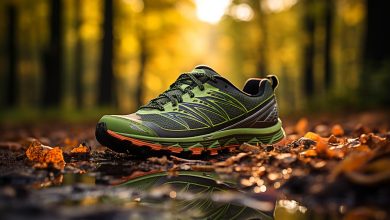Training Tips for Trail Running

Are you ready to hit the trails and conquer the great outdoors? Lace up your shoes and get ready to take your running game to new heights with these trail training tips.
Strengthen your muscles, gear up with the right footwear, tackle those hills like a pro, fuel yourself with proper nutrition, and prevent injuries along the way.
Get ready to elevate your trail running experience and become a force of nature on those rugged paths. Let’s dive in!
The Importance of Strength Training

If you want to improve your trail running performance, you should prioritize strength training. Incorporating resistance exercises into your training routine will not only help build muscular strength but also enhance your overall endurance and stability. Trail running requires a lot of power and stability, especially when navigating through uneven terrains and steep inclines. By engaging in regular strength training sessions, you can effectively target specific muscle groups that are crucial for trail running.
One of the key areas to focus on is core stability. A strong core helps maintain proper posture and balance while running on unpredictable terrain. Core exercises such as planks, Russian twists, and mountain climbers can significantly improve your ability to handle the challenges posed by varying trail conditions.
Resistance exercises like squats, lunges, and deadlifts can strengthen your lower body muscles, including quadriceps, hamstrings, glutes, and calves. These exercises simulate the movements required during trail running and help develop the necessary leg strength to tackle uphill climbs and downhill descents with ease.
Incorporating upper body resistance exercises like push-ups or pull-ups can also contribute to better arm swing mechanics while running on trails.
Remember to gradually increase the intensity of your strength training workouts to avoid overexertion or injury. Consult with a professional trainer who specializes in trail running if you need guidance on developing an effective strength training program tailored to your individual needs.
Proper Footwear and Gear

Wearing the right shoes and gear is essential for a successful trail run. When it comes to choosing the right shoes, there are a few key factors to consider.
1. Traction: Opt for shoes with deep lugs or aggressive tread patterns to provide better grip on uneven terrain. This will help prevent slipping and sliding, allowing you to maintain stability throughout your run.
2. Protection: Look for shoes that offer adequate protection for your feet. Trail running often involves encountering rocks, roots, and other obstacles that can cause discomfort or injury if not properly cushioned or reinforced.
3. Stability: Find shoes that provide good ankle support and stability to prevent sprains or twists on rugged trails. Look for features like a firm midsole or added support around the heel area.
4. Water resistance: Depending on where you’re running, it’s important to consider whether your shoes should be water-resistant or quick-drying. This will help keep your feet dry and comfortable in wet conditions, preventing blisters and other issues.
In addition to choosing the right footwear, there are also essential gear items to consider for trail running:
– Moisture-wicking clothing to keep you dry
– A hydration pack or water bottle
– Sunscreen and hat for sun protection
– GPS watch or smartphone app for navigation
Hill Training Techniques

To improve your hill running abilities, it’s important to incorporate interval training into your workout routine. Interval training involves alternating between periods of high-intensity effort and recovery. This type of training not only helps build strength and endurance but also enhances your ability to tackle hills with ease.
One effective way to incorporate interval training for hill running is by using a technique called hill repeats. Find a steep hill or incline that challenges you, and sprint up the hill at maximum effort for about 30 seconds. Then, walk or jog back down the hill to recover. Repeat this process for a total of 6-8 intervals. This will simulate the demands of uphill running while allowing your body sufficient recovery time.
In addition to interval training, mastering proper breathing techniques can greatly enhance your performance on hills. Focus on taking deep breaths in through your nose and exhaling forcefully through your mouth during both the uphill and downhill portions of your run. This will help supply oxygen to your muscles and keep you energized.
Furthermore, pacing strategies play a crucial role in conquering hills effectively. Start off conservatively at the beginning of an uphill section, maintaining a steady pace that you can sustain throughout the climb. As you approach the peak, increase your effort gradually without going all out too soon.
Remember that practice makes perfect when it comes to hill running. By incorporating interval training, utilizing proper breathing techniques, and employing smart pacing strategies, you’ll become a stronger and more confident runner on any terrain.
| Hill Training Techniques |
|---|
| – Incorporate interval training with hill repeats |
| – Practice proper breathing techniques |
| – Implement smart pacing strategies |
Nutrition and Hydration Tips

Proper nutrition and hydration are essential for optimal performance when tackling hills. To ensure you have the energy and stamina needed to conquer those challenging inclines, follow these tips:
1. Pre-race fueling: Before heading out for a trail run, make sure to eat a balanced meal containing carbohydrates, protein, and healthy fats. This will provide your body with the necessary fuel to sustain you throughout your run.
2. Hydration: It’s crucial to stay properly hydrated before, during, and after your run. Drink plenty of water in the hours leading up to your workout and bring along a water bottle or hydration pack on the trail.
3. Electrolyte replenishment: Sweating during hill training can cause an imbalance of electrolytes in your body. To avoid this, consider consuming sports drinks or electrolyte supplements that can help replace lost minerals like sodium and potassium.
4. Post-run recovery: After completing an intense hill workout, it’s important to refuel your body with a combination of protein and carbohydrates within 30 minutes post-exercise. This will aid in muscle repair and glycogen replenishment.
Injury Prevention Strategies

Make sure you listen to your body and incorporate proper warm-up and cool-down exercises into your routine to prevent injuries. When it comes to trail running, taking care of your body is crucial for a successful training experience. Recovery methods play a significant role in injury prevention, and one of the most effective ways to recover is through stretching exercises.
Stretching not only helps increase flexibility but also improves blood circulation, reduces muscle soreness, and aids in recovery. Before hitting the trails, make sure you spend at least 10 minutes warming up your muscles with dynamic stretches such as leg swings, hip circles, and arm circles. These movements will help prepare your body for the intensity of trail running.
After your run, it’s important to cool down properly by performing static stretches. Focus on stretching major muscle groups like quadriceps, hamstrings, calves, and hip flexors. Hold each stretch for at least 30 seconds without bouncing or forcing the movement.
Additionally, incorporating recovery methods such as foam rolling or using a massage ball can help release tension in tight muscles and promote faster recovery. Don’t forget to hydrate well after each run and get enough rest between training sessions.
Conclusion
In conclusion, trail running is a challenging and exhilarating sport that requires dedication and proper preparation. By incorporating strength training into your routine, you can improve your overall performance and reduce the risk of injuries.
Investing in the right footwear and gear will provide you with the necessary support and protection on uneven terrain. Hill training techniques will enhance your endurance and help you conquer those steep inclines.
And don’t forget to fuel your body with proper nutrition and stay hydrated throughout your runs. Remember, each step you take on the trail is an opportunity for growth, both physically and mentally.
So lace up those shoes, hit the trails, and let the adventure begin!






